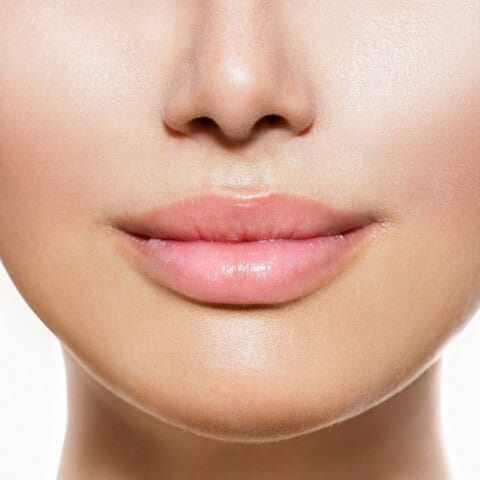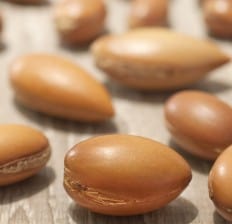The Amazing Argan Oil Benefits

Buy it Now : Click Hero
Imagine a fruit so nutritious that goats will climb trees just to eat them!Inside that little fruit, is the little nut that gives us argan oil. For generations, natives of the Argan Forest in Morocco have pressed the nut to extract this precious oil, to use as a dietary supplement, for wound healing and rash relief, and to nourish skin and hair. These slow-growing trees are so revered that in 1998 the Argan Forest was declared a Biosphere Reserve By UNESCO.
Argan Oil Benefits Throughout History
Argan
oil use was not just isolated to Morocco. People throughout the world
have taken advantage of the many argan oil benefits to treat skin infections, bug bites, and skin rashes. And now it is used by men and women all over the world seeking an effective, all natural moisturizer for skin and hair.
One
of the main reasons that argan oil is so healing, is that it is rich
with vitamin A and vitamin E. However, argan oil is also packed with
anti-oxidants, Omega-6 fatty acids, and linoleic acid. Research shows
that when applied to skin, it eases inflammation while moisturizing the
skin.
When
applied externally, trocopherol from the vitamin E, helps to boost cell
production while promoting healthy skin and hair. This is why cosmetic
companies are including it in their high-end anti-aging, hair, and skin
care products.The good news, to get all of the benefits of this precious little nut, you don’t have to purchase luxury hair and skin care products. You can purchase just the oil, making it a versatile addition to your beauty routine. True, 100% argan oil is expensive; but fortunately, just a drop or two will nourish hair and skin throughout the day.
Top 12 Argan Oil Benefits
Here are 12 of the ways that you can incorporate this anti-aging, moisturizing, and all-natural oil into your daily beauty regimen.Buy it Now : Click Hero
1. Nighttime Moisturizer
In the winter months, or in dryer climates, you may need a second drop; but remember to use sparingly. This oil is gentle, and safe to use around your eyes.
Apply one drop to your face, using a tapping motion, from the bridge of your nose to your temple, and back again. Then apply a drop beneath your eyes with the same gentle tapping. The vitamin A and vitamin E can help to reduce fine wrinkles and keep this delicate area moisturized.
2. Skin Toner
Skin toning is an important step in your skin care routine. For an all-over glow, add 2-4 drops to 8 ounces of your favorite toner, or better yet, make your own chemical free, all natural toner at home!Simply pour one cup of boiling water over a green tea bag and let steep for 7-10 minutes. Remove the tea bag and allow to come to room temperature. Add a drop or two of your favorite essential oil (orange, lemon or tea tree are great), and 2-4 drops of argan oil, and seal in a jar. Use morning and night after cleansing, and before moisturizing.
3. Exfoliating
Do-it-yourself exfoliators are not difficult to make, and are significantly less expensive than what you can purchase in the store, plus when you add argan oil, you get all the anti-aging effects too!To experience the argan oil benefits while exfoliating, just mix 1 tablespoon of brown sugar with a couple of drops of argan oil in your hand. Rub into your face in a circular motion for 2-4 minutes; pay special attention to acne prone areas and areas that are dry. Rinse with warm water, and pat dry.
Regular exfoliation helps to remove dead skin cells and reduce the appearance of fine lines and wrinkles, while giving you a younger fresher complexion. With the aid of the brown sugar, the argan oil’s nutrients are more readily absorbed into your skin.
Use this exfoliator for more than just your face! If you have dry elbows or heels (or during an at-home pedicure) mix up a bit more to massage the dry and dead skin away!
4. Acne
Great news for anyone that is suffering from acne – argan oil has been proven to reduce sebum levels in individuals with oily skin! Women than have never had acne before are finding in that in their 30s and 40s this pesky condition arises, and it is often, difficult to treat.
Chemical creams can be expensive, and in the long run truly do more harm than good. Argan oil’s high linoleic acid content helps to reduce inflammation caused by acne, (not to mention rashes, infections and bug bites) while helping heal damaged skin cells.
If you are using argan oil as your moisturizer, but are still fighting acne, place a drop in the palm of your hand and lightly dab a bit extra into problem areas. To fight stubborn or persistent white heads, be sure to make the toner above, using a couple of drops of tea tree oil.
Tea tree oil compliments the argan oil benefits beautifully with its rich content of anti-oxidants and its inherent anti-bacterial, anti-viral, and anti-fungal properties(3). Together, they can help fight stubborn acne while reducing the inflammation, and scarring.
5. Stretch Marks
Argan oil can help prevent stretch marks by improving the elasticity of the skin. Warm 2-3 drops of pure argan oil in the palm of your hands and gently rub your stomach, hips, thighs or any other potential problem areas.The vitamin A and vitamin E will help to rejuvenate the skin while moisturizing, making stretch marks less likely to form. If you already have a stretch mark or two (or six), start by massaging argan oil and brown sugar into the affected areas before your next bath. Rinse well and apply the oil to the affected areas prior to dressing.
6. Razor Bumps and Burn
Razor bumps and razor burn are uncomfortable and unsightly. Argan oil is an effective treatment to soothe and heal for men after shaving, as well as women for their legs and bikini line.
Warm a drop or two of the oil in your hands and lightly massage into the affected area. The healing power of the oil will astound you. Some individuals note a reduction in the number of ingrown hairs present as well.
7. Whole-Body Moisturizer
Once you see amazing ways that argan oil benefits your face, do not hesitate to use it as your whole-body moisturizer! Hopefully, you are currently using an all-natural moisturizer (like coconut oil) on your body and avoiding the harsh hidden chemicals that are present in most lotions and moisturizers.Add just a couple of drops of argan oil to your food-grade carrier oil of choice (coconut, olive, jojoba, sweet almond, or sesame) to immediately reap all the benefits of this healing natural oil. If you have dry patches on your heals, elbows or other areas, massage an extra drop into those areas for relief.
8. Leave-In Conditioner & Styling
There is some research that indicates argan oil can even promote hair growth, so be sure to rub it in to your scalp too. Depending on the thickness, texture, condition, and length of your hair, you may need anywhere from 1 drop to 3 drops.
Getting the right amount may take some practice. Start with a drop (or for short hair ½ drop may do) and warm in your palms before raking your fingers through your hair, paying special attention to your ends. Once complete, add ½ drop to your fingertips and massage into your scalp. Rub any excess into your face, neck or hands.
9. Overnight Deep Conditioning Treatment
If you have dry, brittle hair, once a week do an overnight deep conditioning treatment with argan oil. Warm 4-10 drops in your hands before massaging into your scalp. Continue applying all the way to the ends, twist, and place a shower cap on top. Your natural body heat retained in the shower cap will help the oil to penetrate, while keeping your pillowcase free of oil. In the morning, wash your hair as normal, rinsing until all residue is gone.If you have dandruff or dry scalp, do an overnight treatment twice per week until dandruff is gone. Continue on with weekly treatments, or as needed.
10. Lip Conditioner
Argan oil benefits more than just your skin and hair; it makes for a wonderful lip treatment or chap stick substitute! Rub in 1-2 drops, and wipe away any excess.
This will not only heal any cracked lips, but also keep your lips soft, smooth and conditioned. Keep argan oil around in winter-time to prevent chapped lips.
11. Nails
Now, let’s talk about how this can help your nails! Argan oil’s non-greasy moisture is an ideal treatment for cuticles and nails. Remove all polish from fingernails and toenails, and rinse thoroughly.Dot a fraction of a drop directly onto each nail, one at a time, and rub into the nail bed and cuticle. Leave on until all nails have been treated.
Wash and rinse thoroughly and then apply polish as desired. The oil will help to condition your nails, but also help keep your cuticles moisturized so you don’t develop painful hangnails.
12. Dry Feet and Heels
Buy it Now : Click Hero
If you have dry cracking skin on your feet or heels, rub 2 drops into your feet, paying special attention to the problem areas. Depending on the how dry your skin is, you may need to apply a couple of more drops to fully moisturize the area.Cover with a pair of cozy socks to give the oil a chance to soak in. Leave the socks on for at least 20 minutes, and preferably overnight.
NOTE: Please use a warm washcloth to remove all of the residual oil from the bottom of your feet prior to bathing! We wouldn’t want you to slip and fall!
How to Store Argan Oil
As you can see, argan oil is easy to incorporate into your morning and evening beauty routine. To enjoy all the argan oil benefits, use it daily to treat dry skin and scalp, as a styling product, to keep wrinkles at bay, and to treat acne. It increases the hydration of your skin(4) and hair resulting in a more youthful and healthy appearance.Keep bottles out of direct sunlight, and sealed tight. It is recommended to use the oil within 6 months of opening for optimal benefit. Start with a small bottle, and keep track of how long it lasts. Don’t buy too large of a bottle at first, as the quality can degrade over time.
Where to Buy to Argan Oil
Buy it Now : Click Hero
One more important note…it is important to get actual high-quality oil. Unfortunately, there are many unscrupulous companies that are taking advantage of consumers by replacing argan oil (in part or in whole) for cheap knock-offs.A low-quality oil will not give you the same argan oil benefits as it will not have the same concentration of nutrients. You get what you pay for, so it is definitely worth it to be wary and read labels carefully. So when selecting your argan oil, look for pure 100% argan oil that has been cold-pressed.
A good, pure argan oil will be more expensive, but when you look at the number of products (eye creams, moisturizers, lotions, hair styling products, etc.) you can replace, it is worth every penny. I personally use ORGANIC Argan Oil 100% PURE & ECOCERT Certified by IntaNatural.
Argan Oil Side Effects
Argan oil is an all-natural alternative to the chemical-laden beauty products you have in your home. The anti-oxidants, Omega-6 fatty acids, and the linoleic acids help fight fine lines, reduce inflammation, heal acne, and minimize scars and stretch marks, and so much more.
Buy it Now : Click Hero














